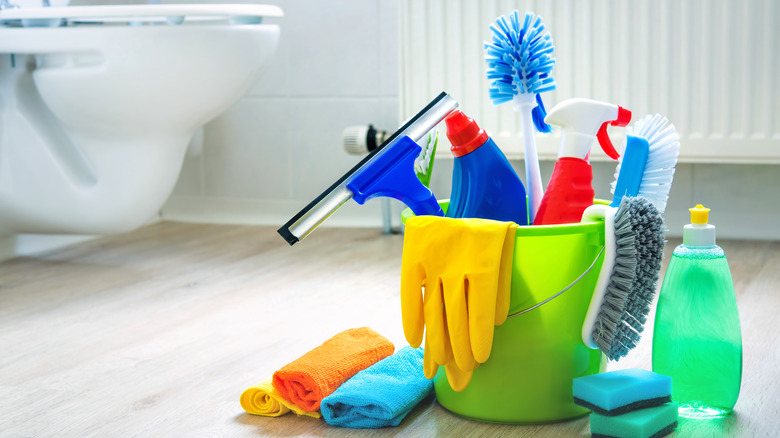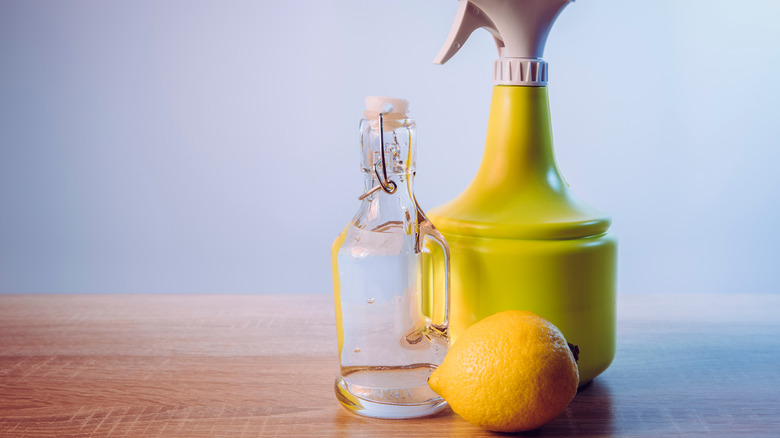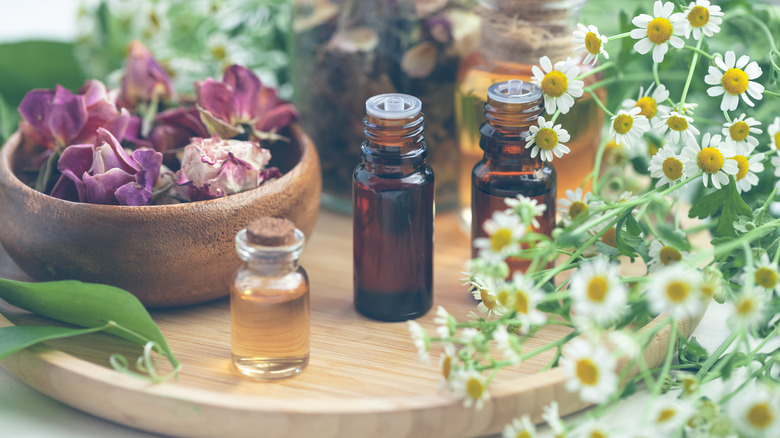Here's What You Can Substitute For Toilet Cleaner
Flush toilets first came into widespread use in the 1850s, and china toilets were introduced in 1922 (per Old House Online) — needless to say, it was a crowning achievement in modern sanitation and comfort. However, this advance created a new problem to solve: how best to clean them. The go-to answer was chemicals. They are still used today, but these harsh and corrosive substances can pollute your house and compromise the health of the user, children, and household pets.
Many conventional toilet cleaning products contain hydrochloric acid, muriatic acid, or chlorine. They can irritate the eyes and skin, and sensitivity to them can set off an asthma attack. The Toxic Use Reduction Institute (TURI) warns that mixing incompatible cleansers might even create a chlorine gas cloud in your bathroom. Substituting inexpensive natural cleaning agents for caustic synthetic chemicals is a safe and effective way to perform the heinous, but necessary task of cleaning your toilet.
Benign and readily available cleaners include white vinegar, baking soda, citrus juice, and table salt. Others include hydrogen peroxide, cornstarch, and borax (sodium tetraborate), a powerful whitener, deodorizer, and stain fighter. A stiff scrubbing brush or sponge, spray bottle, toothbrush, rubber gloves, and rags or paper towels are also essential supplies for cleaning your commode.
Toilet cleaning recipes
Whether you use chemicals or not, properly cleaning a toilet means contacting all surfaces. That means the bowl, lid, tank, handle, hinges, and seat. A note of caution: Test a small area first if cleaning a colored seat. An all-purpose cleaning solution comprised of ¼ cup of baking soda (sodium bicarbonate) and a cup of white vinegar will work wonders on your toilet, as per Tips.Net. Baking soda (a base) will react with vinegar (an acid) to create a fizzy cleanser. Mix and dump them in the bowl, wait several minutes, scrub, and flush. A ½ cup of lemon juice and a cup of borax will also be effective in blasting away stains and rings in the toilet. A concoction of an olive-based soap and borax or sodium bicarbonate also works well, and you can even try dissolving denture tablets in the bowl or tank to attack stains.
Speaking of stains, many are caused by mold, mildew, or hard water containing a high percentage of minerals. A buildup of lime can leave a green or brown residue. Rust can also form in your bowl. Once again, white vinegar will come to the rescue. According to the United States Geological Survey, vinegar's acidity works to dissolve mineral deposits in the toilet bowl, and it will also zap mildew. Home Made Simple suggests using up to three gallons of vinegar to clean the tank after first microwaving it for a couple of minutes to boost its effectiveness.
Other helpful hints
You can also use essential oils when cleaning your toilet. Many are capable of defeating the three main bathroom foes: bacteria, viruses, and fungi. Tea tree oil is particularly effective, and lemon juice, like vinegar, will bind to mineral stains and make them easier to wipe off, as explained by DIY Natural. The natural deodorizing properties of oils, such as peppermint, lavender, eucalyptus, and rosemary, can prevent your bathroom from smelling like a public urinal. Bob Vila advises using a glass bowl or wooden spoon when working with essential oils to avoid unwanted reactions with metal or plastic.
For the most effective clean, you may want to drain the water in the toilet bowl before starting. There is a water valve at the toilet's base that can be turned off. Then flush to expose the soiled surfaces. Toilet grout and caulk can be cleaned with natural ingredients and a toothbrush. Alternatively, a pumice stone can be used instead of a brush for scrubbing — surprisingly, it won't harm porcelain. Paper towels or rags should be discarded after use, and instruments should be cleaned before being returned to storage. Martha Stewart offers an additional tip for those using rubber gloves to clean a toilet: Wash your gloved hands before removing the protective layer, then clean your hands thoroughly. Your hands and toilet will be spotlessly clean as a result.


